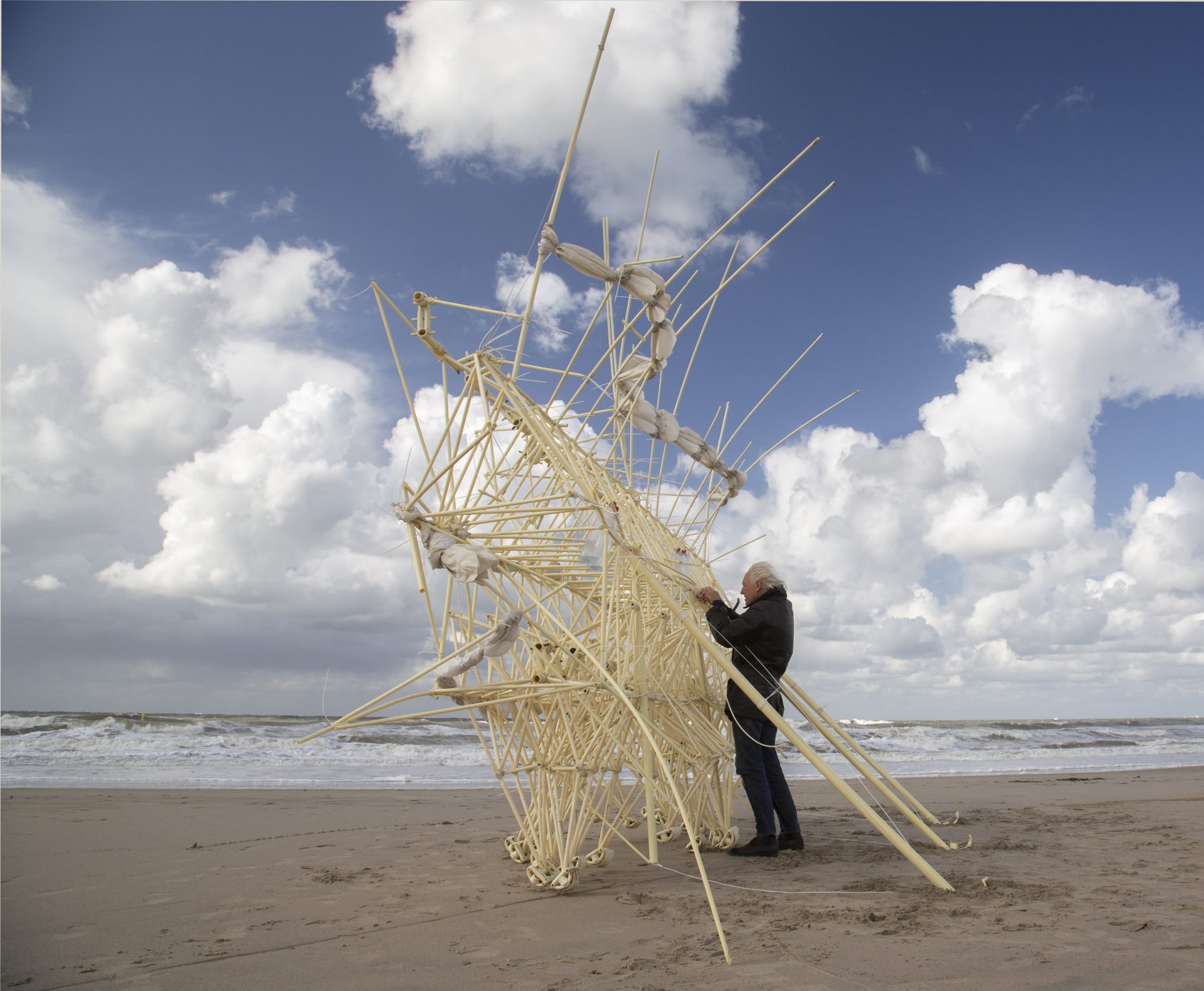The works of Theo Jansen are incredible: you look at them and you remain open-mouthed, as if you were seeing moving living organisms, which seem to come out of some science fiction movie or some crazy engineer, and instead are pieces of art more unique than rare.
Theo Jansen is a Dutch artist active mainly in the field of kinetic sculpture. His most famous creations are the Strandbeesten (beach animals), large mobile structures built by connecting and articulating thin yellow PVC tubes, of the type used in electrical engineering for the canalization of electrical wiring, assembled with adhesive tape, elastic bands, and zip ties. In addition to these materials, recycled polyethylene bottles, wooden sticks, and even pallets were used. All recycled items found as waste on beaches.
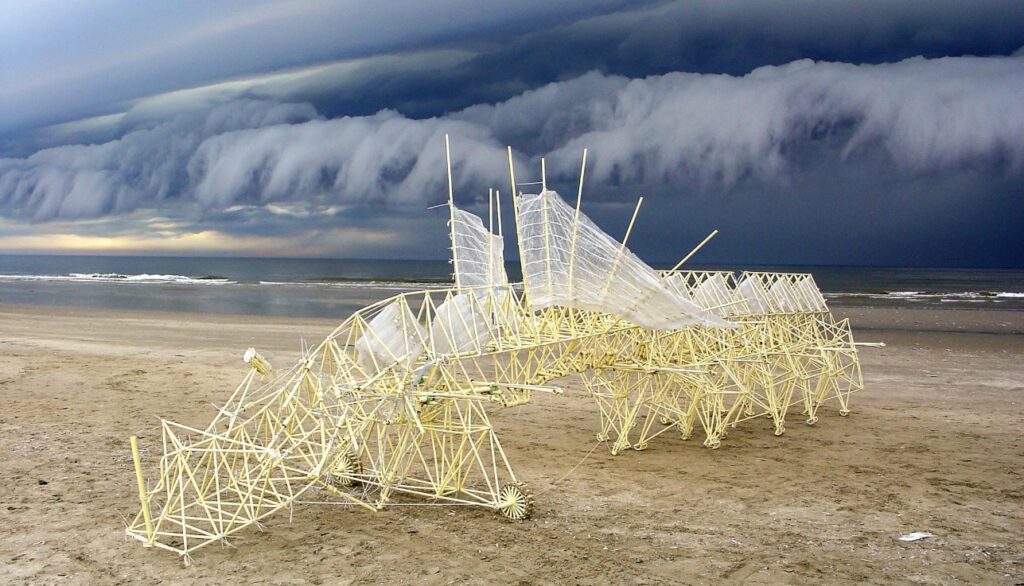
Let’s get to know the artist better: who is Theo Jansen?
Theo Jansen, born in Scheveningen-The Hague on March 14, 1948, is an artist capable of presenting works that lie on the borderline between artistic creation and engineering design.
The Strandbeesten are the most famous works. Similar in appearance to giant insects, or large animal skeletons, his creatures are able to walk on Dutch beaches by using the energy of the wind. Over time, they have also acquired forms of homeostasis, with the ability to store wind energy in bottles, in the form of compressed air, to ensure forms of autonomy in the absence of wind. However, even with the implementation of rudimentary perceptual abilities towards the external environment, through simple sensors made from the same basic materials, a combination of elements that allows the Strandbeest to modify their behavior based on perceptions.
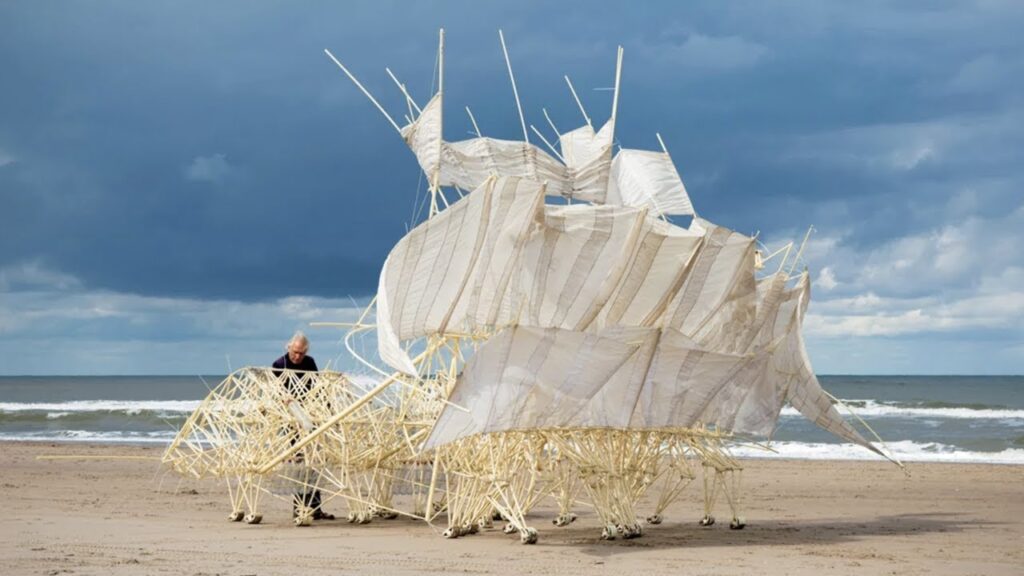
Jansen, from 1967 to 1975, studied physics at the Technische Hogeschool Delft (now Technische Universiteit Delft). After the university experience he decided to undertake the artistic activity, devoting himself for seven years to painting and drawing.
The creations of Theo Jansen
His first experience of kinetic art dates back to 1980, when a black flying saucer, made on a framework of PVC pipes, spread panic flying in the sky of Delft, supporting itself in the air thanks to the helium with which it was filled, accompanying its flight with the emission of a sound signal and the lighting of flashing lights.
The flying object finally disappeared in the clouds, losing all trace of itself: it landed perhaps in Belgium and was never found. A similar experience was repeated the following year in the skies over Paris.
In the years from 1984 to 1986, Jansen conceived The painting machine, development of a device for automatic painting on walls, by means of a spray gun used to detect light and darkness by an optical sensor: the spray paint is dispensed only when the machine detects a condition of absence of light.
Theo Jansen’s kinetic sculptures that seem alive
The works for which he is best known are the Strandbeesten, the animals of the beach, a sort of animated skeletons whose propulsive energy is drawn from the wind, to which he started to dedicate himself already in the eighties.
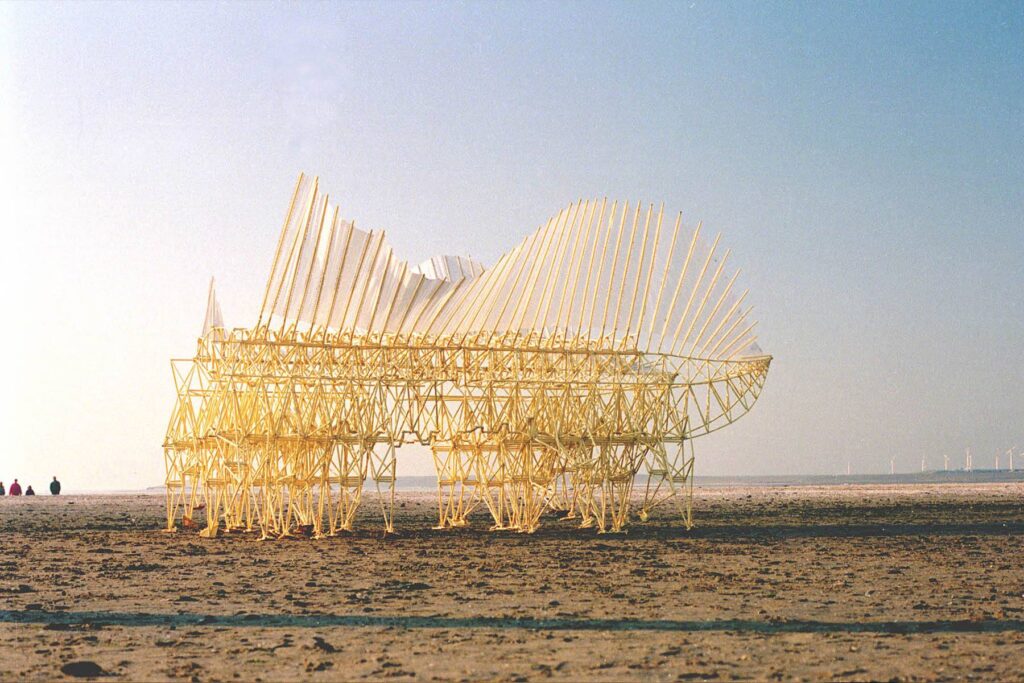
The first of his Strandbeests was Animaris vulgaris, a fictional binomial that derives from the fusion of two Latin terms, animal and maris, and that can be translated into English as Common animation. This first composition, made of PVC tubes and tape, was not yet able to move. The beach beasts, in fact, were originally intended to be simply displayed on the sand and coastal dunes. Only later did Jansen take on the technical challenge of imprinting them with forms of autonomous movement. To do this, the strandbeesten are equipped with «wings», a sort of wind vanes placed on the back of the sculpture, whose activation is able to support the mechanism of lateral walking of the creatures, in a movement during which they always keep their ‘nose’ in the direction of the wind.
Evolution of the Strandbeesten
In the later stages of the project, interested in the process of evolution, Jansen tried to select computer models, reproducing on his creatures the same mechanisms by which natural selection acts on the evolution of living species.
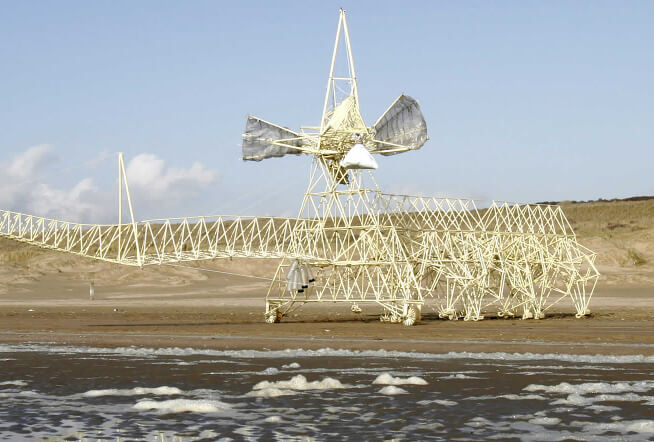
This is how other generations of beach animals have followed over time, able to move on the sand, under the push of the wind, thanks to an ingenious movement developed by the legs. With time, Jansen has implemented the ability to store energy autonomously, in the form of compressed air. A step towards the conquest of autonomy, thanks to the ability to move even in the absence of wind.
Movement in the absence of wind
Those same wings can then drive several small bicycle pumps that insufflate air under pressure inside a tank (“the stomach” of the beasts, in the words of its creator) consisting of a battery of simple PET bottles. The wind energy stored in this way, during a recharging process that requires a few hours of exposure to the atmospheric elements, can then be used to move autonomously even in the absence of wind.
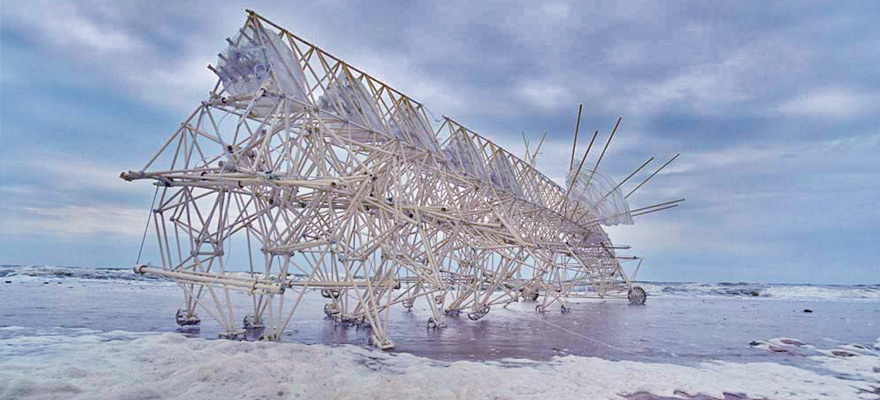
The compressed air acts on what the designer defines as the «muscles», or even better, the «extensible bones» of the animal. These are elementary pneumatic pistons made up of two coaxial PVC tubes of different diameters, whose pneumatic seal is guaranteed by an o-ring over the inner tube. The flow of air stored in the bottles, passing through a small tube, stretches the pistons and allows the movement. «Muscles can open the bottle caps to activate other muscles that open other caps and so on. This gives rise to control centers that can be likened to brains».
Locomotion mechanism
Peculiar is the mechanism of the terrestrial locomotion: his creations don’t use wheels, that on the beach wouldn’t guarantee a good grip, but they rely on a real and more efficient mechanism of walking, that produces a lateral caracollating gait.
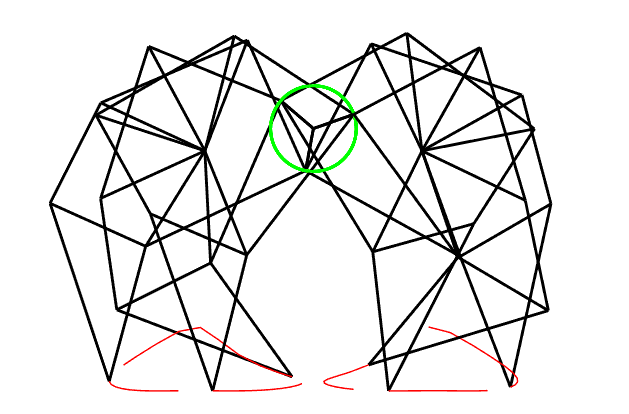
Sensitivity to water and strong wind
Crucial is the ability of the creatures to perceive and react to some adverse and potentially fatal circumstances for their survival, such as the risk of going into the open sea; ending up submerged or overwhelmed by water; or the risk of falling into the mercy of a strong wind.
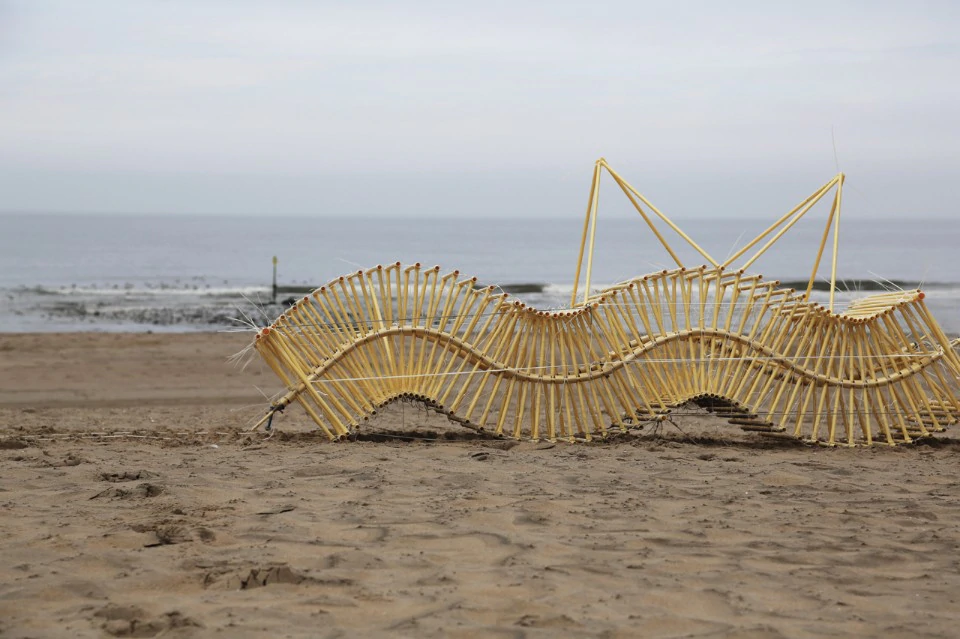
Through uniquely mechanical and pneumatic sensors, Jansen implemented the ability to sense the presence of water at their feet, or dry sand in the dunes. The creatures react to these stimuli by stopping movement and starting in the opposite direction. Other sensors also have the ability to sense the presence of strong wind, thanks to a pin hinged in the sand, under the percussion of a hammer driven by a pneumatic piston.
Memory
The creatures, moreover, are now equipped with a pedometer; a small pneumatic brain that memorizes the number of steps in a binary configuration, and is able to provide the sculpture with «a kind of imagination of the simple world of beach animals» whose boundaries extend into the wet sand between the two extremes imposed by the coastal dunes and the shoreline.
STRANDBEETS: ART IN MOTION
Bizarre creatures, yet perfect, moved by the force of nature. We can only imagine the surprise and the beauty of being in front of these enormous beasts that move in front of the sea.
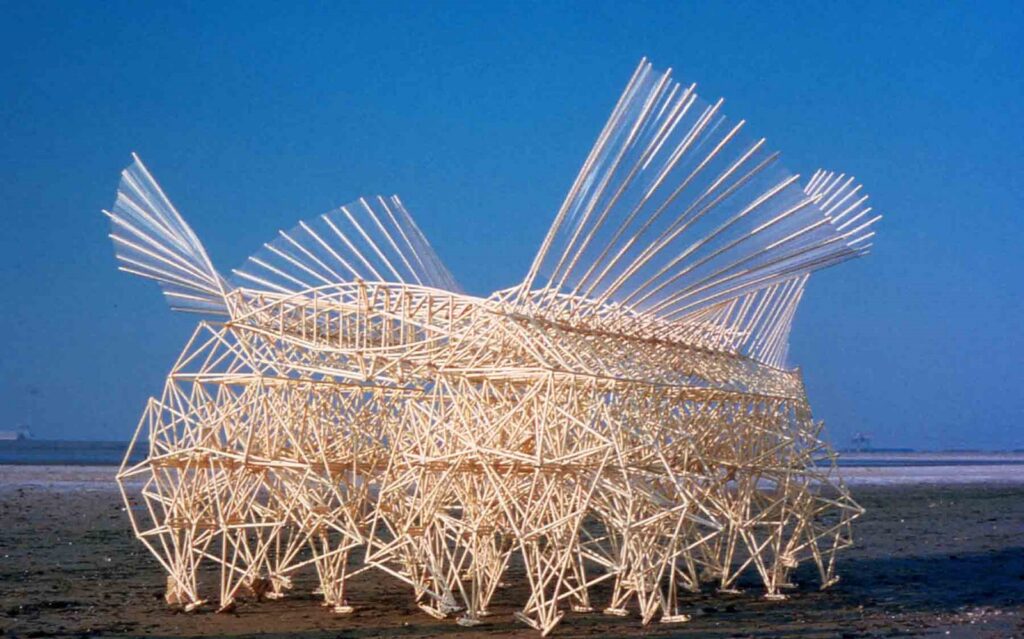
In line with the thought of the great Leonardo da Vinci, the Dutch artist Theo Jansen, combines his engineering experience with artistic flair to reach the creation of self-propelled creatures of extraordinary and mysterious beauty; Strandbeests, the animals of the beach. Like the mechanical devices that Leonardo designed in the 15th Century, the creatures of this contemporary artist contain an archaic and at the same time futuristic feeling. Theo Jansen makes kinetic sculptures that are “alive”, as they are able to animate and walk; therefore he likes to call them “a new form of life”. In February 2019, during the 500th anniversary of Leonardo Da Vinci’s death, the Museum of Science and Technology in Milan exhibited precisely the kinetic sculptures of Dutchman Theo Jansen, considered an artist who pays homage to the spirit of the great master.
STRANDBEETS: ECOLOGICAL DESIGN AND RECYCLED MATERIALS
Theo Jansen is a true recycling artist capable of creating not only a fusion of art and science, but a true ecological design: a new species of beach animals!
From an early age, Jansen had the elements in front of him that would allow him to practice his art: the sea and the wind.
“… When I work at the beach, under the clouds, these categories become irrelevant. I feel like an outdoor Eskimo, working by confrontation with nature.
It is only at the end of the process, when I see them move, that I am surprised by the beauty of the creatures…”
From them the Strandbeeets were born. Some of these, are able to store energy without the need for futuristic engines, since they have a “stomach” made of … plastic bottles (strictly recycled or discarded as waste)!
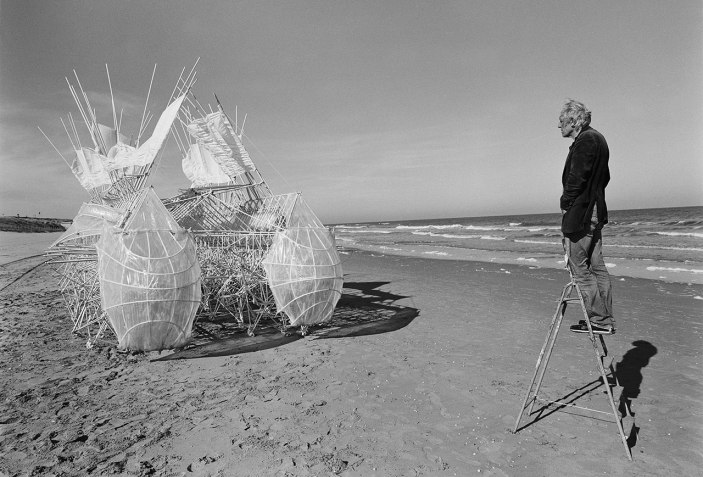
Art and engineering, but also recycling of waste materials, thus contribute to give life to these almost magical creatures, with elegant movements, completely ecological, which could also be an inspiration for more “consumer” applications based on wind energy.
Theo Jansen gives us a very important lesson: science and nature can live together and create spectacular art.
If you’d like to learn more about how to create artwork and paint sustainably, I recommend reading also https://www.thegreensideofpink.com/2020/10/28/dipingere-rispettando-lambiente-e-la-salute/amp/.


